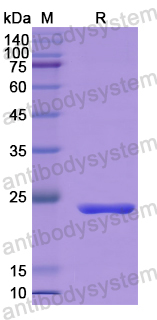Catalog No.
YHJ59301
Expression system
E. coli
Species
Homo sapiens (Human)
Protein length
Phe694-Arg885
Predicted molecular weight
23.81 kDa
Nature
Recombinant
Endotoxin level
Please contact with the lab for this information.
Purity
>90% as determined by SDS-PAGE.
Accession
Q9HB75
Applications
ELISA, Immunogen, SDS-PAGE, WB, Bioactivity testing in progress
Form
Lyophilized
Storage buffer
Lyophilized from a solution in PBS pH 7.4, 0.02% NLS, 1mM EDTA, 4% Trehalose, 1% Mannitol.
Reconstitution
Reconstitute in sterile water for a stock solution. A copy of datasheet will be provided with the products, please refer to it for details.
Shipping
In general, proteins are provided as lyophilized powder/frozen liquid. They are shipped out with dry ice/blue ice unless customers require otherwise.
Stability and Storage
Use a manual defrost freezer and avoid repeated freeze thaw cycles. Store at 2 to 8°C for frequent use. Store at -20 to -80°C for twelve months from the date of receipt.
Alternative Names
Leucine-rich repeat and death domain-containing protein, PIDD1, p53-induced death domain-containing protein 1, PIDD, LRDD
Unraveling ADHD: genes, co-occurring traits, and developmental dynamics., PMID:40000109
A hierarchical pathway for assembly of the distal appendages that organize primary cilia., PMID:39882846
Dysregulation of mTOR signalling is a converging mechanism in lissencephaly., PMID:39743596
YTHDF2 promotes arsenic-induced malignant phenotypes by degrading PIDD1 mRNA in human keratinocytes., PMID:39675544
Ally or traitor: the dual role of p62 in caspase-2 regulation., PMID:39543123
Noncanonical altPIDD1 protein: unveiling the true major translational output of the PIDD1 gene., PMID:39532532
Caspase-2 kills cells with extra centrosomes., PMID:39475598
Stepwise phosphorylation and SUMOylation of PIDD1 drive PIDDosome assembly in response to DNA repair failure., PMID:39448602
Microglia aggravate white matter injury via C3/C3aR pathway after experimental subarachnoid hemorrhage., PMID:38866102
Dissecting caspase-2-mediated cell death: from intrinsic PIDDosome activation to chemical modulation., PMID:38676703
A multi-ancestry GWAS of Fuchs corneal dystrophy highlights the contributions of laminins, collagen, and endothelial cell regulation., PMID:38582945
Extra centrosomes delay DNA damage-driven tumorigenesis., PMID:38552015
DCAF13 inhibits the p53 signaling pathway by promoting p53 ubiquitination modification in lung adenocarcinoma., PMID:38163876
A noncanonical IRAK4-IRAK1 pathway counters DNA damage-induced apoptosis independently of TLR/IL-1R signaling., PMID:38113335
Bi-allelic truncating variants in CASP2 underlie a neurodevelopmental disorder with lissencephaly., PMID:37880421
Total recall: the role of PIDDosome components in neurodegeneration., PMID:37716905
Got PIDD1? Natural killer cells clear polyploid cells to ensure a balanced genome., PMID:37691515
Extra centrosomes induce PIDD1-mediated inflammation and immunosurveillance., PMID:37530438
A Non-Canonical IRAK Signaling Pathway Triggered by DNA Damage., PMID:36798275
A hierarchical pathway for assembly of the distal appendages that organize primary cilia., PMID:36711481
Molecular basis of neurodevelopmental disorders caused by pathogenic variants of PIDD., PMID:36689811
PIDDosome-SCAP crosstalk controls high-fructose-diet-dependent transition from simple steatosis to steatohepatitis., PMID:36041455
Gene expression profile associated with Asmt knockout-induced depression-like behaviors and exercise effects in mouse hypothalamus., PMID:35771226
Transcriptome Reveals Granulosa Cells Coping through Redox, Inflammatory and Metabolic Mechanisms under Acute Heat Stress., PMID:35563749
PIDD1 in cell cycle control, sterile inflammation and cell death., PMID:35343572
Serum Autoantibodies against LRDD, STC1, and FOXA1 as Biomarkers in the Detection of Ovarian Cancer., PMID:35273656
Targeted Nanotherapeutics Using LACTB Gene Therapy Against Melanoma., PMID:34819728
Significant Difference of Immune Cell Fractions and Their Correlations With Differential Expression Genes in Parkinson's Disease., PMID:34483877
FANCI functions as a repair/apoptosis switch in response to DNA crosslinks., PMID:34256011
Aflatoxin B1 interferes with embryonic liver development: Involvement of p53 signaling and apoptosis in zebrafish., PMID:34214637
Pathogenic variants in PIDD1 lead to an autosomal recessive neurodevelopmental disorder with pachygyria and psychiatric features., PMID:34163010
Analysis of high-risk pedigrees identifies 11 candidate variants for Alzheimer's disease., PMID:34151536
Neat1 decreases neuronal apoptosis after oxygen and glucose deprivation., PMID:34100452
The PIDDosome: centrosome guardian and backup on the DNA damage response., PMID:34027036
Mechanism of filament formation in UPA-promoted CARD8 and NLRP1 inflammasomes., PMID:33420033
Biallelic mutations in the death domain of PIDD1 impair caspase-2 activation and are associated with intellectual disability., PMID:33414379
ANKRD26 recruits PIDD1 to centriolar distal appendages to activate the PIDDosome following centrosome amplification., PMID:33350495
Centriolar distal appendages activate the centrosome-PIDDosome-p53 signalling axis via ANKRD26., PMID:33350486
PIDDosome-induced p53-dependent ploidy restriction facilitates hepatocarcinogenesis., PMID:33225610
Caspase 2 and p53 Reunited in Tumor Control., PMID:32921524
A Switch in p53 Dynamics Marks Cells That Escape from DSB-Induced Cell Cycle Arrest., PMID:32755587
ATR signalling mediates the prosurvival function of phospho-NPM against PIDDosome mediated cell death., PMID:32194167
E2F-Family Members Engage the PIDDosome to Limit Hepatocyte Ploidy in Liver Development and Regeneration., PMID:31983631
Captaining the PIDD ship., PMID:31676017
Exploring genetic variation that influences brain methylation in attention-deficit/hyperactivity disorder., PMID:31582733
Involvement of Upregulated P53-Induced Death Domain Protein in Retinal Ganglion Cells Apoptosis After Optic Nerve Crush., PMID:31533600
PIDD interaction with KEAP1 as a new mutation-independent mechanism to promote NRF2 stabilization and chemoresistance in NSCLC., PMID:31455821
Functional degradation: A mechanism of NLRP1 inflammasome activation by diverse pathogen enzymes., PMID:30872533
Prediction of causal genes and gene expression analysis of attention-deficit hyperactivity disorder in the different brain region, a comprehensive integrative analysis of ADHD., PMID:30738099
PIDD mediates the association of DNA-PKcs and ATR at stalled replication forks to facilitate the ATR signaling pathway., PMID:29309644

